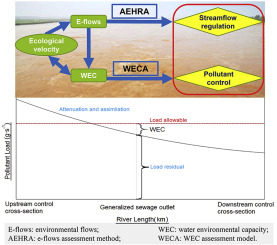Water Research ( IF 11.4 ) Pub Date : 2018-05-15 , DOI: 10.1016/j.watres.2018.05.025 Changsen Zhao , Shengtian Yang , Junguo Liu , Changming Liu , Fanghua Hao , Zhonggen Wang , Huitong Zhang , Jinxi Song , Simon M. Mitrovic , Richard P. Lim

|
The survival of aquatic biota in stream ecosystems depends on both water quantity and quality, and is particularly susceptible to degraded water quality in regulated rivers. Maintenance of environmental flows (e-flows) for aquatic biota with optimum water quantity and quality is essential for sustainable ecosystem services, especially in developing regions with insufficient stream monitoring of hydrology, water quality and aquatic biota. Few e-flow methods are available that closely link aquatic biota tolerances to pollutant concentrations in a simple and practical manner. In this paper a new method was proposed to assess e-flows that aimed to satisfy the requirements of aquatic biota for both the quantity and quality of the streamflow by linking fish tolerances to water quality criteria, or the allowable concentration of pollutants. For better operation of water projects and control of pollutants discharged into streams, this paper presented two coefficients for streamflow adjustment and pollutant control. Assessment of e-flows in the Wei River, the largest tributary of the Yellow River, shows that streamflow in dry seasons failed to meet e-flow requirements. Pollutant influx exerted a large pressure on the aquatic ecosystem, with pollutant concentrations much higher than that of the fish tolerance thresholds. We found that both flow velocity and water temperature exerted great influences on the pollutant degradation rate. Flow velocity had a much greater influence on pollutant degradation than did the standard deviation of flow velocity. This study provides new methods to closely link the tolerance of aquatic biota to water quality criteria for e-flow assessment. The recommended coefficients for streamflow adjustment and pollutant control, to dynamically regulate streamflow and control pollutant discharge, are helpful for river management and ecosystems rehabilitation. The relatively low data requirement also makes the method easy to use efficiently in developing regions, and thus this study has significant implications for managing flows in polluted and regulated rivers worldwide.
中文翻译:

将鱼类的耐受性与水质标准联系起来以评估环境流量:一种用于流量调节和污染控制的实用方法
河流生态系统中水生生物的生存取决于水量和水质,特别容易受到管制河流水质下降的影响。维持具有最佳水量和质量的水生生物的环境流量(电子流)对于可持续的生态系统服务至关重要,尤其是在水文,水质和水生生物的流量监测不足的发展中地区。很少有以简单实用的方式将水生生物的耐受性与污染物浓度紧密联系在一起的电子流方法。在本文中,提出了一种新的方法来评估电子水流,该方法旨在通过将鱼的容忍度与水质标准或污染物的允许浓度联系起来,来满足水生生物量对水流的数量和质量的要求。为了更好地进行水利工程和控制排放到河流中的污染物,本文提出了两个用于流量调节和污染物控制的系数。对黄河最大支流渭河的电子流量进行的评估表明,干旱季节的电子流量无法满足电子流量的要求。污染物的涌入对水生生态系统造成了巨大压力,污染物浓度远高于鱼类耐受阈值。我们发现流速和水温都对污染物的降解速度有很大的影响。流速对污染物降解的影响比流速的标准偏差大得多。这项研究提供了新的方法,可以将水生生物的耐受性与水质标准进行电子流评估紧密联系起来。推荐的流量调节和污染物控制系数,以动态调节流量并控制污染物排放,有助于河流管理和生态系统恢复。相对较低的数据要求也使该方法易于在发展中地区有效使用,因此,本研究对管理全球受污染和管制的河流中的流量具有重要意义。











































 京公网安备 11010802027423号
京公网安备 11010802027423号